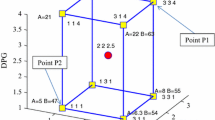Abstract
A robust kinetic numerical model for natural rubber NR–poly-butadiene PB blends vulcanized with sulfur is presented. For a preliminary experimental insight used then as benchmark, a 70% NR with 30% high-cis PB blend vulcanized in presence of sulfur and two accelerants (TBSS and DPG) in different concentrations is tested under standard vulcanization conditions (rheometer) at three different vulcanization temperatures, namely 150, 170 and 180 °C. The numerical model reproduces normalized experimental rheometer curves using a Han’s kinetic model for NR and a modification of the Han’s model proposed recently by the authors for PB. The model bases therefore on existing kinetic approaches that proved to be effective for NR and PB separately, but merging them linearly to cope with NR–PB peculiar reactions occurring in a blend. Han’s model depends on three rate constants, whereas the approach used for PB is characterized by four kinetic parameters. The linear interaction between PB and NR (with amount of rubber involved not a priori known) is again assumed ruled by a Han’s model. The mathematical approach proposed is therefore characterized by 10 rate constants plus an additional parameter represented by NR–PB concentration involved by the interaction. Such constants are estimated by standard best fitting against experimental data. Quite good match is found, showing that the procedure may be useful for practical purposes in all those cases where expensive experimental investigations are not possible.











Similar content being viewed by others
References
H.E. Railsback, W.T. Cooper, Cis-polybutadiene-natural rubber blends. Rubber Chem. Technol. 32(1), 308–320 (1959)
K. Fujimoto, N. Yoshimiya, Blends of cis-1,4-polybutadiene with natural or styrene-butadiene rubber. Rubber Chem. Technol. 41(3), 669–677 (1968)
M. Pazonyl, T. Dimitrov, Preparation and properties of polymer mixtures. Rubber Chem. Technol. 40(4), 1119 (1967)
G. Milani, F. Milani, Comprehensive numerical model for the interpretation of cross-linking with peroxides and sulfur: chemical mechanisms and optimal vulcanization of real items. Rubber Chem. Technol. 85(4), 590 (2012)
G. Milani, F. Milani, Kinetic model for S–TBBS–DPG NR vulcanization: extrapolation from S–TBBS and S–DPG experimental data. J. Theor. Comput. Chem. 15(8), 1–33 (2016). (paper no. 16500)
G. Milani, F. Milani, Curing degree prediction for S–TBBS–DPG natural rubber by means of a simple numerical model accounting for reversion and linear interaction. Polym. Testing 52, 9–23 (2016)
G. Milani, T. Hanel, R. Donetti, F. Milani, Combined experimental and numerical kinetic characterization of NR vulcanized with sulphur, N-terbutyl,2-benzothiazylsulphenamide and N,N-diphenyl guanidine. J. Appl. Polym. Sci. (2016). https://doi.org/10.1002/app.43519. (paper no. 43519)
G. Milani, T. Hanel, F. Milani, R. Donetti, A closed form solution for the vulcanization prediction of NR cured with sulphur and different accelerators. J. Math. Chem. 53(4), 975–997 (2015). https://doi.org/10.1007/s10910-014-0456-4
G. Milani, F. Milani, Closed form numerical approach for a kinetic interpretation of high-cis-polybutadiene rubber vulcanization. J. Math. Chem. 55(2), 552 (2017)
D.W. Van Krevelen, Properties of polymers (Elsevier, New York, 1990), p. 102
M.L. Studebaker, J.R. Beatty, Chapter 9, in Science and technology of rubber, ed. by F.R. Eirich (Academic Press, New York, 1978)
M. Akiba, A.S. Hashim, Vulcanization and crosslinking in elastomers. Prog. Polym. Sci. 22, 475 (1997)
A.S. Aprem, K. Joseph, S. Thomas, Recent developments in crosslinking of elastomers. Rubber Chem. Technol. 78(3), 458–488 (2005)
B. Likozar, M. Krajnc, Modelling the vulcanization of rubber blends. Marcomol. Symp. 243, 104 (2006)
A.I. Isayev, J.S. Deng, Non isothermal vulcanization of rubber compounds. Rubber Chem. Technol. 61, 340 (1988)
M.R. Kamal, S. Sourour, Kinetics and thermal characterizationof thermoset cure. Polym. Eng. Sci. 13, 59 (1973)
A.Y. Coran, Chemistry of the vulcanization and protection of elastomers: a review of the achievements. J. Appl. Polym. Sci. 87, 24–30 (2003)
R. Ding, I. Leonov, A kinetic model for rubber accelerate vulcanization of a natural rubber compound. J. Appl. Polym. Sci. 61, 455 (1996)
I.S. Han, C.B. Chung, Kang Sj, H.C. Chung, A kinetic model of reversion type cure for rubber compounds. Polymer (Korea) 22, 223 (1998)
G. Milani, F. Milani, Iterative robust numerical procedure for the determination of kinetic constants in Han’s model for NR cured with sulphur. J. Math. Chem. 52(2), 464 (2015)
G. Milani, F. Milani, Parabola–hyperbola P–H kinetic model for sulphur vulcanization. Polym. Testing 58, 104–115 (2017)
J. Nocedal, S. Wright, Numerical optimization (Springer, New York, 1999)
X. Sun, A.I. Isayev, Cure kinetics study of unfilled and carbon black filled synthetic isoprene rubber. Rubber Chem. Technol. 82, 149 (2009)
M. Szwarc, C.H. Leigh, Frequency factor in a series of similar unimolecular reactions. Nature 167, 486–487 (1951)
G. Lente, A novel method to compute the time dependence of state distributions in the stochastic kinetic description of an autocatalytic system. Comput. Chem. Eng. (2017). https://doi.org/10.1016/j.compchemeng.2016.08.001
Author information
Authors and Affiliations
Corresponding author
Rights and permissions
About this article
Cite this article
Milani, G., Milani, F. Rubber blends: kinetic numerical model by rheometer experimental characterization. J Math Chem 56, 1520–1542 (2018). https://doi.org/10.1007/s10910-018-0887-4
Received:
Accepted:
Published:
Issue Date:
DOI: https://doi.org/10.1007/s10910-018-0887-4




